Discover 35 hidden attractions, cool sights, and unusual things to do in Gainesville (United States). Don't miss out on these must-see attractions: Florida Museum of Natural History, Devil's Millhopper Geological State Park, and Thomas Center. Also, be sure to include Ben Hill Griffin Stadium in your itinerary.
Below, you can find the list of the most amazing places you should visit in Gainesville (Florida).
Table of Contents
Florida Museum of Natural History
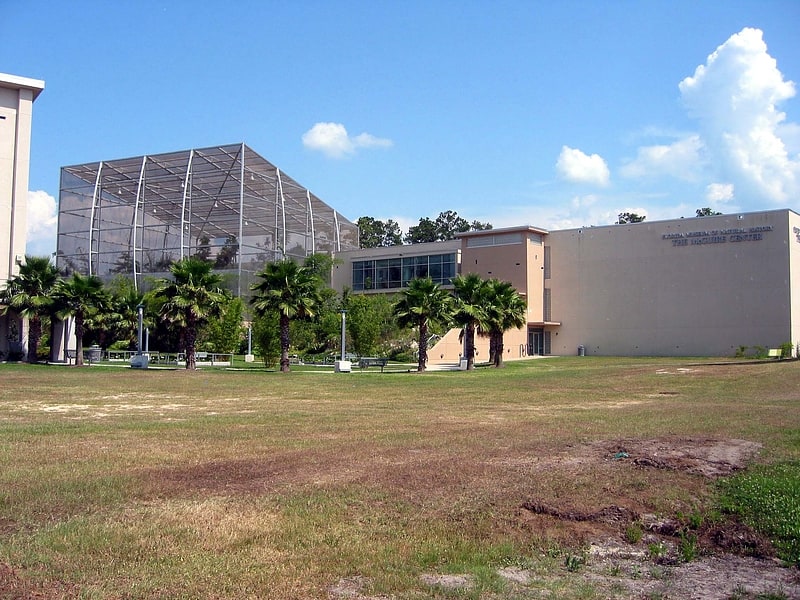
Exhibits on the region's land and culture. The Florida Museum of Natural History is Florida's official state-sponsored and chartered natural-history museum. Its main facilities are located at 3215 Hull Road on the campus of the University of Florida in Gainesville.
The main public exhibit facility, Powell Hall and the attached McGuire Center, is located in the Cultural Plaza, which it shares with the Samuel P. Harn Museum of Art and the Curtis M. Phillips Center for the Performing Arts. The main research facility and former public exhibits building, Dickinson Hall, is located on the east side of campus at the corner of Museum Road and Newell Drive. On April 18, 2012, the American Institute of Architects's Florida chapter placed Dickinson Hall on its list of Florida Architecture: 100 Years. 100 Places as the Florida Museum of Natural History / Formerly Florida Museum of Natural Sciences.
Powell Hall's permanent public exhibits focus on the flora, fauna, fossils, and historic peoples of the state of Florida. The museum does not charge for admission to most exhibits; the exceptions are the Butterfly Rainforest and certain traveling exhibits.
The museum's collections were first used for teaching at Florida Agriculture College in Lake City in the 1800s, and were relocated to the campus of the University of Florida in 1906. The museum was chartered as the state's official natural history museum by the Florida Legislature in 1917. Formerly known as the Florida State Museum, the name was changed in 1988 to more accurately reflect the museum's mission and help avoid confusion with Florida State University, which is located in Tallahassee.
The Florida Museum of Natural History partnered with the Alachua County Library to help provide zoom events, virtual tours, and online exhibits so that visitors can stay involved despite the changes the library has endured due to the COVID-19 pandemic.[1]
Address: 3215 Hull Rd, 32611 Gainesville
Devil's Millhopper Geological State Park
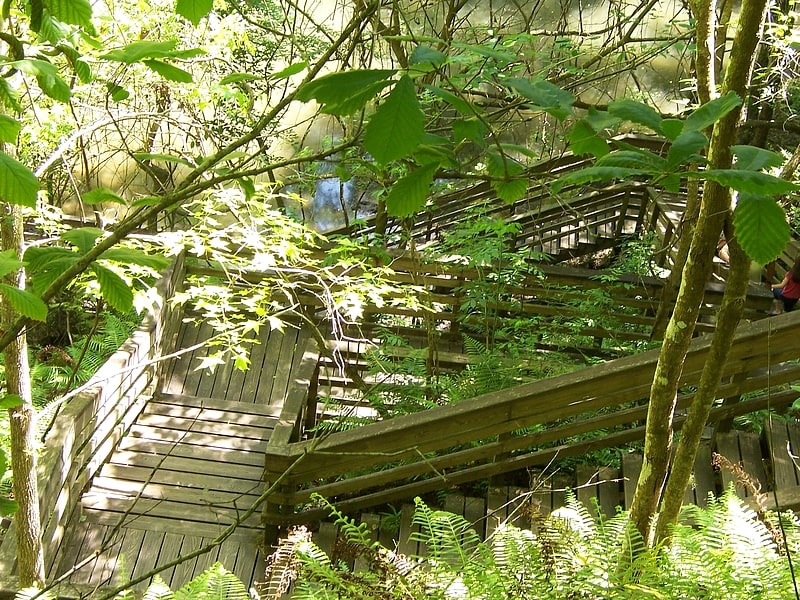
State park in Alachua County, Florida. Devil's Millhopper Geological State Park is a Florida State Park located in the north-westernmost part of Gainesville, Florida, off County Road 232, also known as NW 53rd Avenue and Millhopper Road, northwest of the University of Florida.
The park is maintained by the Florida State Parks system, a division of the Florida Department of Environmental Protection. The park is adjacent to San Felasco County Park and is near the San Felasco Hammock Preserve State Park.[2]
Address: 4732 Millhopper Road, 32653 Gainesville
Thomas Center

Building in Gainesville, Florida. The Thomas Center, formerly known as Hotel Thomas and Sunkist Villa, is an historic building in Gainesville, Florida, United States. It was built starting in 1910 in the Classical Revival style by noted Atlanta-based architect, William Augustus Edwards, designer of academic buildings at 12 institutions in Georgia, South Carolina and Florida, including the original University of Florida campus, as well as a dozen or more county courthouses in those states plus other building and houses,
The building began as the private home of William Reuben Thomas, his wife Kathryn, and their five children, when it was known as Sunkist Villa. In 1928 Thomas more than doubled the size of the home and converted it to a hotel. On July 16, 1973, the building was added to the U.S. National Register of Historic Places.
The Thomas Center celebrated its 100th anniversary on February 12, 2010.[3]
Address: 302 NE 6th Ave, 32601-5476 Gainesville
Ben Hill Griffin Stadium
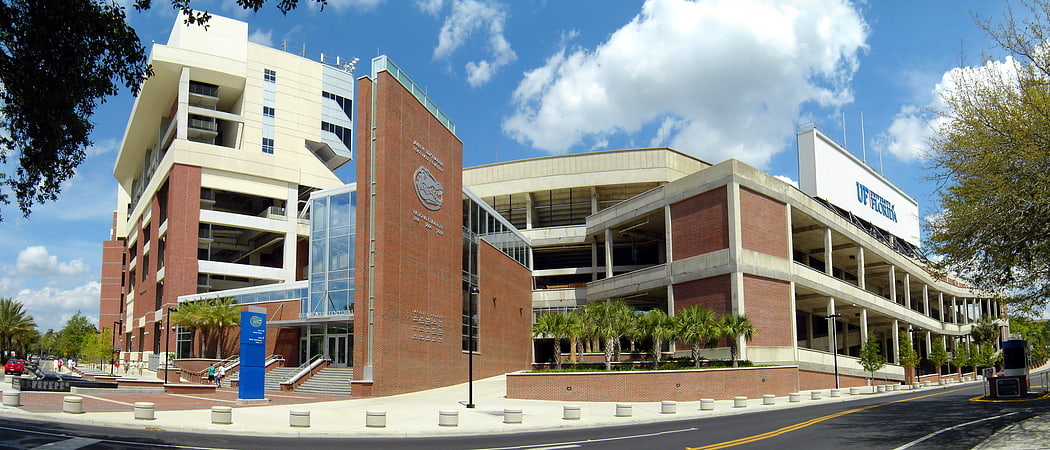
Stadium in Gainesville, Florida. Ben Hill Griffin Stadium, popularly known as "The Swamp", is a football stadium on the campus of the University of Florida in Gainesville and the home field of the Florida Gators football team. It was originally known as Florida Field when it opened as a 22,000 seat facility in 1930, and it has been expanded and renovated many times over the ensuing decades. Most of the university's athletic administrative offices, along with most football-related offices and training areas, have been located in the stadium since the 1960s. Most of the football program's facilities are slated to move to a nearby $60 million building that began construction in 2020.
Ben Hill Griffin Stadium is the largest stadium in Florida, the 12th largest stadium in the United States, and the 18th largest stadium in the world, as measured by its official seating capacity of 88,548 – though, it has often held over 90,000 for Florida's home football games.[4]
Address: Stadium RD, 32611-2051 Gainesville
Samuel P. Harn Museum of Art

The Samuel P. Harn Museum of Art is an art museum at the University of Florida in Gainesville, Florida. It is in the UF Cultural Plaza area in the southwest part of campus.
The Harn is a 112,800-square-foot-facility, making it one of the largest university art museums in the South. This includes 40,400 square feet of exhibition space, 5 garden spaces, a 250-seat auditorium, museum store, study center, café and classroom spaces. The museum has a permanent collection and an array of temporary exhibitions. The Harn's permanent collection totals more than 11,300 objects, which are focused on Asian, African, modern and contemporary art, as well as photography. The museum sponsors international and Florida-centric exhibitions. The university sponsors educational programs at the museum including films, lectures, interactive activities, and school and family offerings.
In October 2005 the Harn expanded by more than 18,000 square feet with the opening of the Mary Ann Harn Cofrin Pavilion, which includes new educational and meeting areas and the Camellia Court Cafe, the first eatery for visitors of the Cultural Plaza. In August 2021, it was announced that it will be expanding with a new wing of 20,000 square-foot.
The museum is accredited by the American Alliance of Museums. UF offers a virtual tour for prospective visitors.[5]
Address: SW 34th St and Hull RD, 32611-0001 Gainesville
Stephen C. O'Connell Center
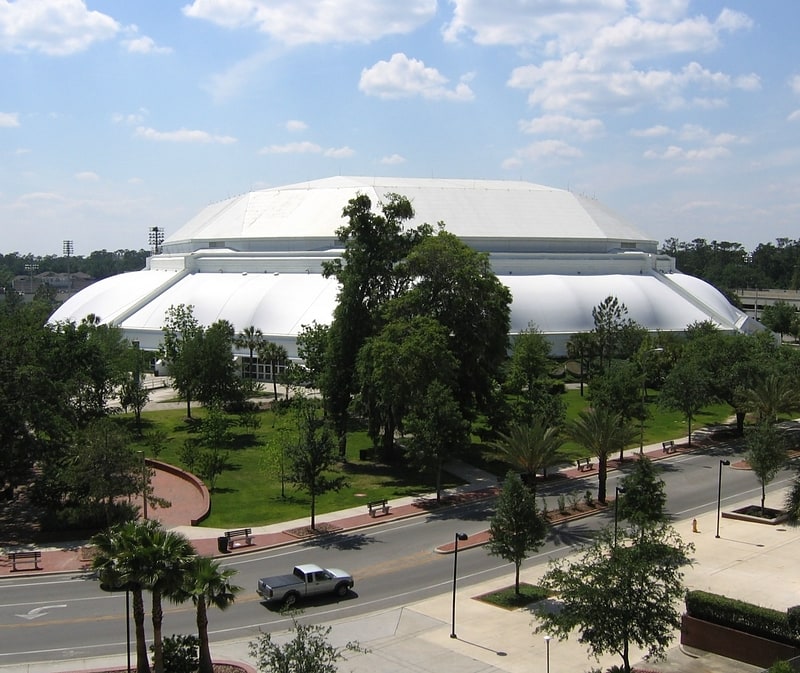
Arena in Gainesville, Florida. The Stephen C. O'Connell Center, also known as the O'Dome, is a 10,500-seat multi-purpose arena located on the University of Florida campus in Gainesville, Florida. The facility is named for the sixth president of the university, Stephen C. O'Connell, who served from 1967 to 1973. The facility is located on the northern side of the university's campus, between its football field, Ben Hill Griffin Stadium at Florida Field, and the James W. "Bill" Heavener Complex athletic training center.
The entire facility was known as the O'Connell Center from 1980 until 2016. The building underwent a major $64.5 million renovation / reconstruction during that year, and Exactech, a Gainesville medical firm, signed a $5.9 million, 10-year naming rights deal for the main arena, which was officially renamed the Exactech Arena at the Stephen C. O'Connell Center.[6]
Address: 250 Gale Lemerand Dr, 32611-2044 Gainesville
IDigBio
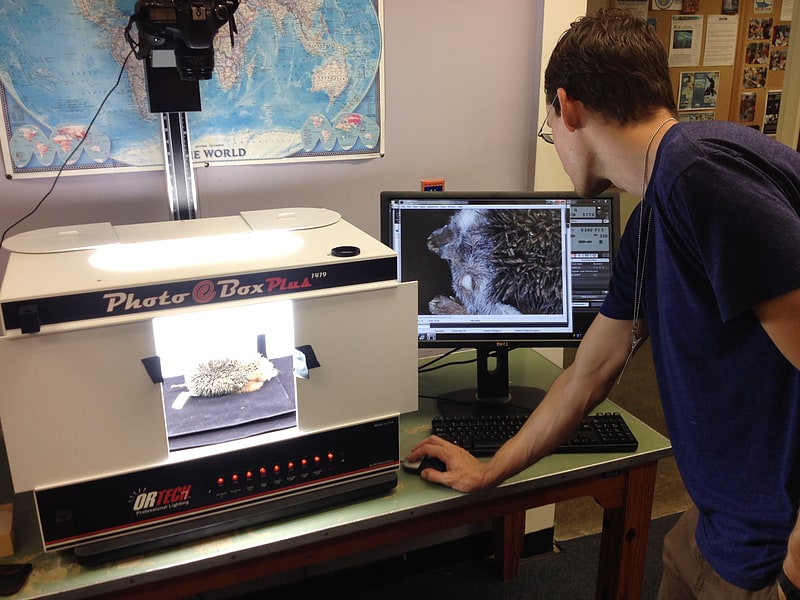
iDigBio, Integrated Digitized Biocollections, is the National Resource funded by the National Science Foundation for Advancing Digitization of Biodiversity Collections. Through iDigBio, data and images for millions of biological specimens are being curated, connected and made available in electronic format for the biological research community, government agencies, students, educators, and the general public. The mission of iDigBio is to develop a national infrastructure that supports the vision of ADBC by overseeing implementation of standards and best practices for digitization; building and deploying a customized cloud computing environment for collections; recruiting and training personnel, including underserved groups; engaging the research community, collections community, citizen scientists, and the public through education and outreach activities; and planning for long-term sustainability of the national digitization effort. In addition to the iDigBio central digitization HUB, there are partner institutions referred to as “Thematic Collections Networks” and associated “Partners To Existing Networks which consists of networks of institutions with a strategy for digitizing information that addresses a particular research theme. Through the iDigBio HUB cyberinfrastructure, compilation and the inter-linking of data from the TCNs and existing collaborative databases will create opportunities to address research questions and education interests regarding biodiversity, climate change, species invasions, natural disasters, and the spread of pests and diseases. New TCNs will be funded in succeeding years based on solicitations from NSF. The iDigBio HUB is based at the University of Florida, in partnership with Florida State University.[7]
Hippodrome State Theatre
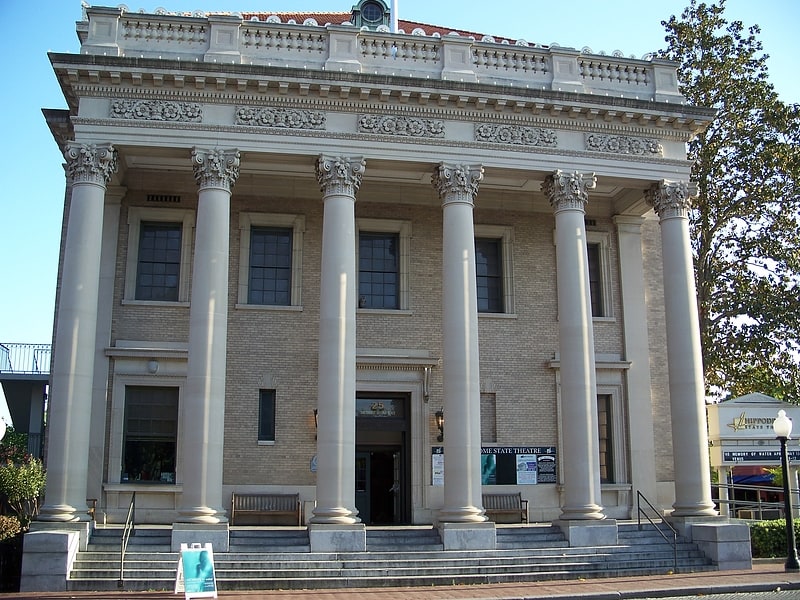
The Hippodrome Theatre is a regional professional theatre in downtown Gainesville, Florida, United States. It was founded in 1973 by local actors and was added to the U.S. National Register of Historic Places on July 10, 1979.[8]
Address: 25 SE 2nd Pl, 32601-6567 Gainesville
Lake Alice
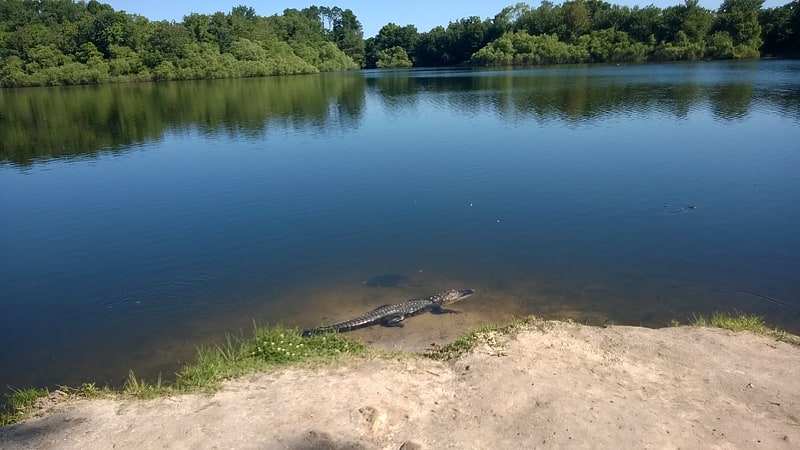
Lake in Florida. Lake Alice is a small lake on the University of Florida campus in Gainesville, Florida, United States.
The lake is a wildlife area and is one of the few areas in incorporated Gainesville where one may view live alligators. The lake also harbors a population of Florida softshell turtles. The university's bat house is near the lake. The Baughman Center sits on the southwest bank of the lake. On Lake Alice's northern side, there is a boardwalk that leads visitors through the woods and swamp to a viewing platform.
The people of the Alachua culture who built a burial mound near the College of Law on University of Florida’s campus (the "Law School Mound") c 1000 AD are believed to have lived along the shore of Lake Alice.
How Lake Alice obtained its name is uncertain. Prior to the 1890s, Lake Alice was known as "Jonah's Pond" but by 1894, US Geological Surveys noted it as Lake Alice. A Master's thesis written in 1953 makes the unreferenced claim that it was named for the only daughter of a Mr. Witt, who owned a farm of which the lake was a part.
In the late 1960s, the University of Florida administration and the Florida Department of Transportation planned to drain portions of the lake and construct a cross-campus throughway and 2,000-car parking lot along its shore. Environmental activist Marjorie Harris Carr, along with University of Florida professors John Kaufmann and Joe Little, led a successful opposition movement that eventually defeated the plan.
In 1988 the University of Florida administration sought to develop the shoreline of Lake Alice with luxury student housing, eliminating the student gardens as well as the bat house in the process. After eleven years of organized protest against the development and a petition opposing it signed by more than 8,000 students, faculty, and other citizens, the proposal was halted on December 8, 1998, when Lawton Chiles, in one of his last acts as governor before his unexpected death three days later, moved at a meeting of the Florida Cabinet to preserve the shoreline, and the motion passed unanimously.
In October 2017, an adult one-eyed alligator was photographed facing Museum Road near the shore.[9]
Kika Silva Pla Planetarium
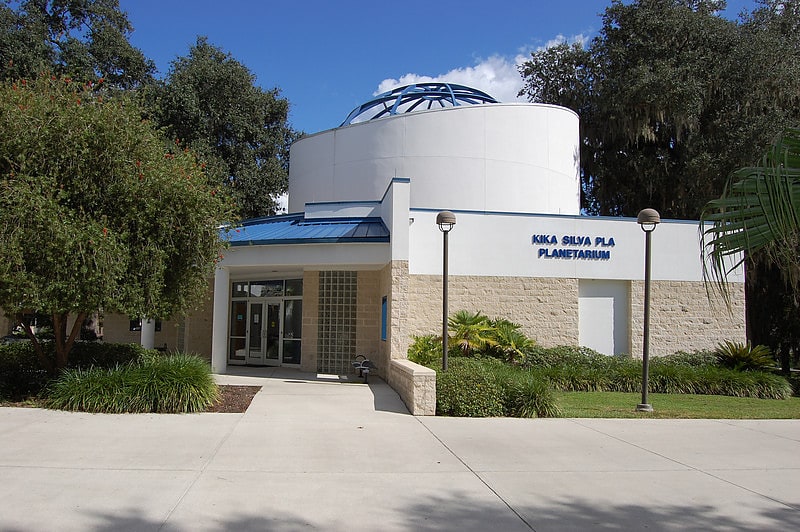
Planetarium in Alachua County, Florida. The Santa Fe College Kika Silva Pla Planetarium is a 34-foot in diameter, domed theater in Gainesville, Florida. The planetarium seats 60 people and uses two projection systems. An In-Space-System 1C-3K digital projection system by RSA Cosmos and an optical-mechanical Chronos Space Simulator manufactured by Goto.[10]
Address: 3000 NW 83rd St # X-129, 32606-6210 Gainesville
Matheson History Museum

The Matheson History Museum Complex is located in Gainesville, Florida. It includes the Matheson History Museum, the Matheson Library & Archives, the 1867 Matheson House, and the Tison Tool Barn.[11]
Address: 513 E University Ave, 32601-5451 Gainesville
Santa Fe College Teaching Zoo

10-acre campus zoo . The Santa Fe College Teaching Zoo is a 10-acre zoo in Gainesville, Florida. As part of Santa Fe College, It is the only college zookeeper training facility in the United States with its own AZA-accredited zoo on grounds, and has been accredited since 2000.
Guided tours led by students in the program are available at the teaching zoo if scheduled ahead of time; visitors may also take a self-guided tours.[12]
Address: 3000 NW 83rd St, 32606-6210 Gainesville
Cade Museum for Creativity and Invention
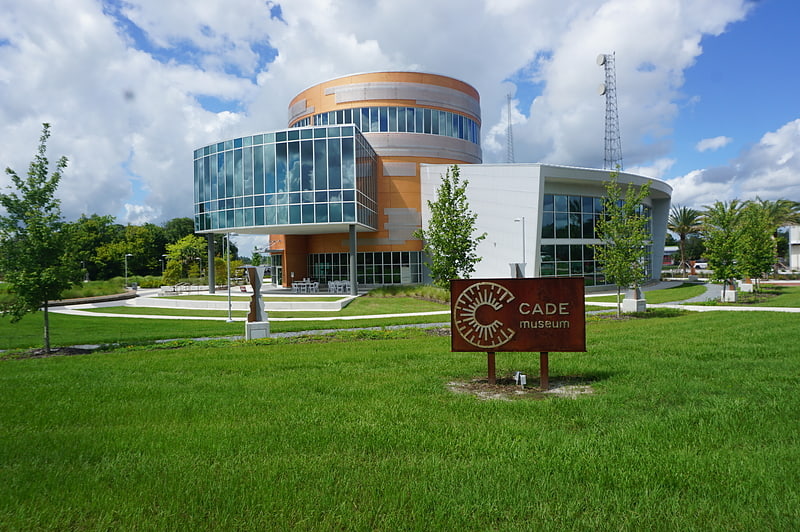
The Cade Museum for Creativity and Invention is a museum in Gainesville, Florida that has a mission “to transform communities by inspiring and equipping future inventors, entrepreneurs, and visionaries.” The museum is named after Dr. Robert Cade, the lead inventor of Gatorade, and reflects his view of combining science and art in a manner of “purposeful creativity”.[13]
Address: 811 S Main St, 32601-7928 Gainesville
Kanapaha Botanical Gardens
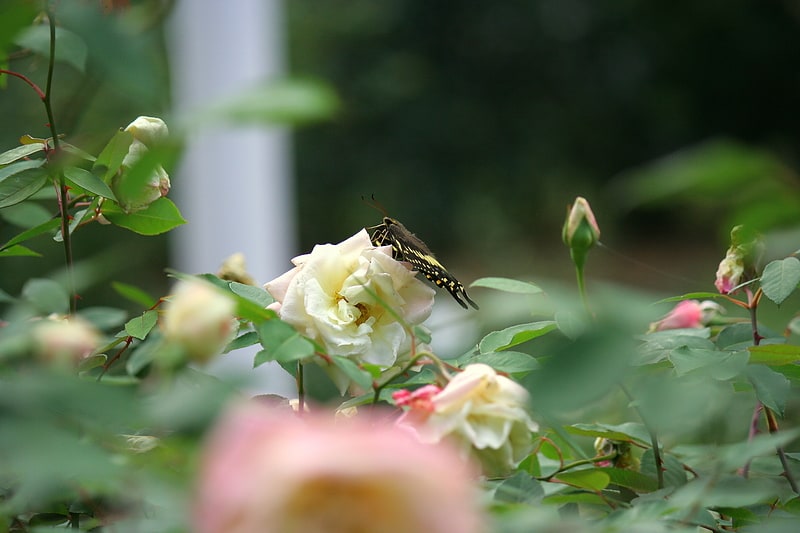
Botanical garden in Alachua County, Florida. The Kanapaha Botanical Gardens is a botanical garden in Gainesville, Florida, operated by the North Florida Botanical Society. Their name comes from nearby Lake Kanapaha. The gardens were established in 1978 when the society leased 33 acres for a public botanical garden. Another 29 acres were added in 1982. The gardens opened to the public in 1986.
As of 2005, the Kanapaha Botanical Gardens contain Florida's largest public bamboo gardens and the largest herb garden in the Southeast.
The gardens include the following major collections:
- Arboretum
- Azalea/Camellia garden
- Bamboo garden
- Butterfly garden
- Crinum garden
- Cycad garden
- Fern cobble
- Herb garden
- Hummingbird garden
- Palm hammock
- Rock garden
- Rose garden
- Spring flower garden
- Vinery
- Woodland garden
Address: S.W. Archer Road, 32608-0808 Gainesville
Katie Seashole Pressly Softball Stadium
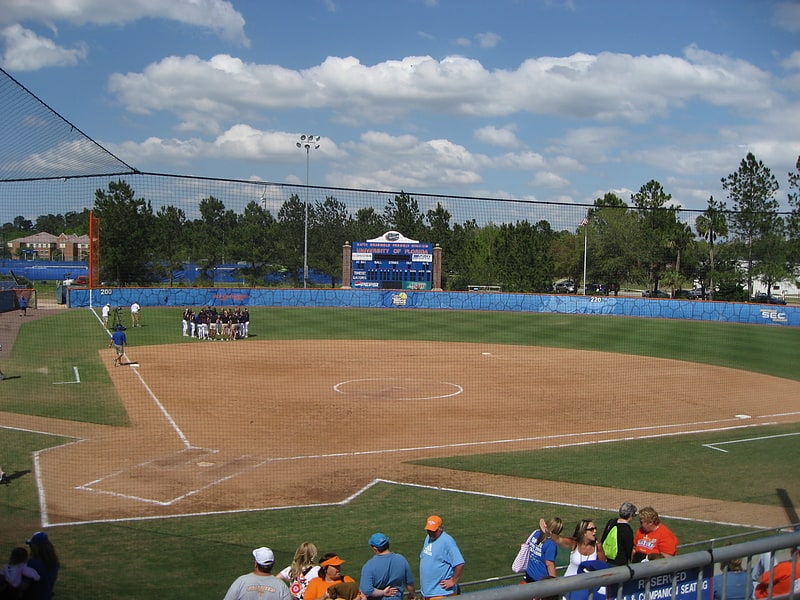
Stadium in Gainesville, Florida. The Katie Seashole Pressly Softball Stadium is the home field of the Florida Gators softball team of the University of Florida. The stadium is located at the corner of Hull Road and Museum Road, on the university's Gainesville, Florida campus.[15]
Address: 2880 Hull Rd, 32611-2065 Gainesville
Haile Homestead
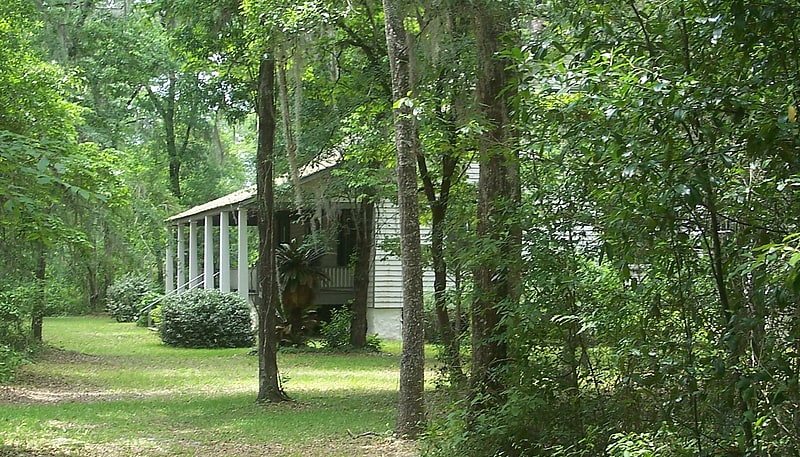
Museum. The Historic Haile Homestead, also known as Haile Plantation House or Kanapaha, is a historic site and museum in Gainesville, Florida, United States. It is located at 8500 SW Archer Rd. SR 24. On May 2, 1986, the plantation house was added to the U.S. National Register of Historic Places.The Homestead is unique in the Nation for its "Talking Walls." For a reason lost to time the Haile family and friends wrote over 12,500 words on the walls, dating back to the 1850s.[16]
Address: 8500 SW Archer Rd, 32608-5513 Gainesville
Yulee Area
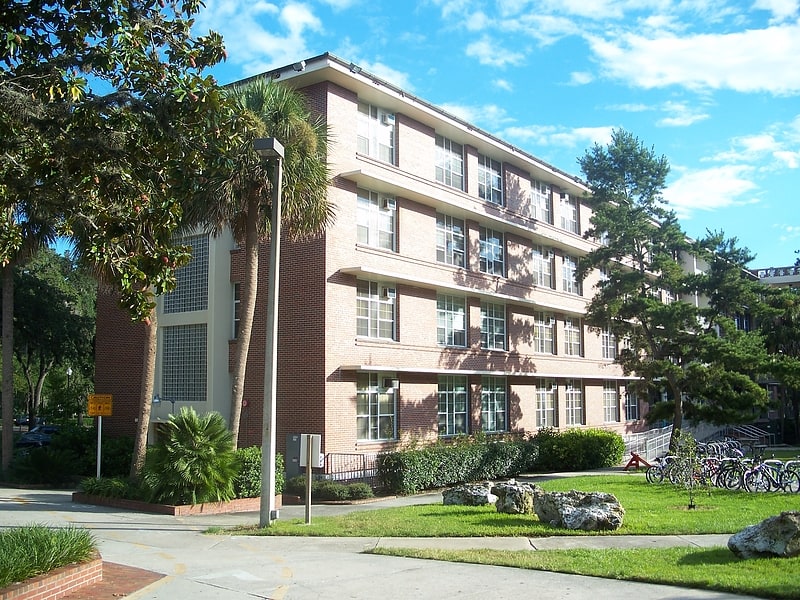
The Yulee area is a historic residence hall complex at 13th Street and Inner Road, SW, on the University of Florida campus in Gainesville, Florida in the United States. It is the site of the first permanent dormitories built for women after the campus became co-educational in 1947. On June 24, 2008, it was added to the National Register of Historic Places.[17]
Address: 1310 Museum Rd, Gainesville
Curtis M. Phillips Center for the Performing Arts
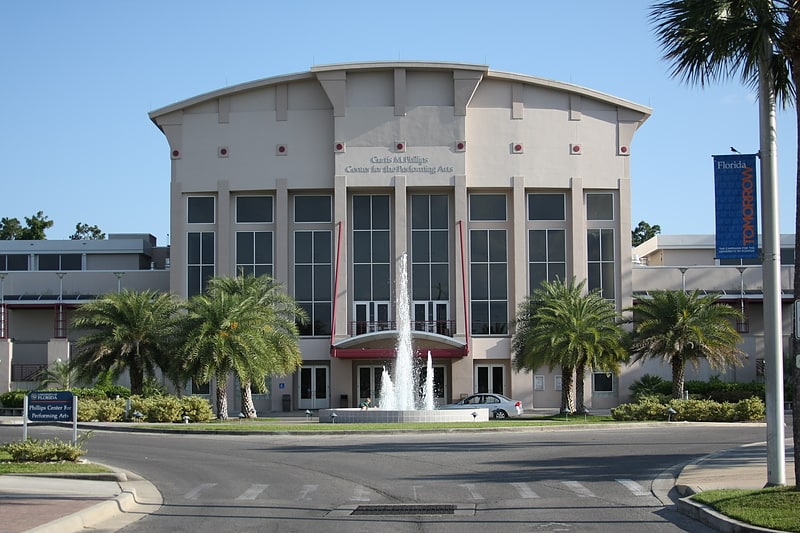
Theatre in Gainesville, Florida. The Curtis M. Phillips Center for the Performing Arts is a performing arts theatre in Gainesville, Florida, United States. It is located on the western side of the University of Florida campus. This facility presents some of the most established and emerging national and international artists on the main stage. In all, the Phillips Center consists of a 1,700-seat proscenium hall and a 200-seat Black Box Theatre. In 2000, retired Jacksonville surgeon Curtis M. Phillips provided The Barbara J. and Curtis M. Phillips M.D. Endowment Fund to name the performing arts center.[18]
Address: Gainesville, 3201 Hull Road, Gainesville, Florida, United States
Morningside Nature Center
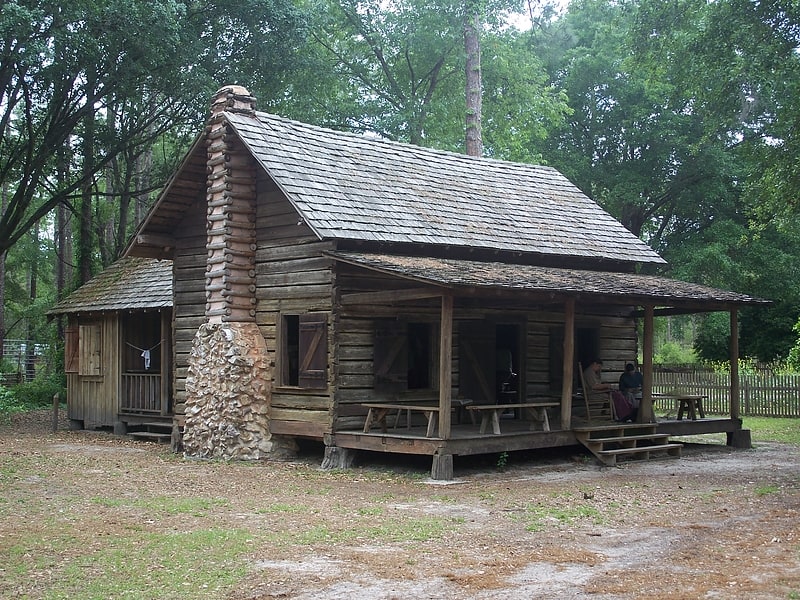
Park in Alachua County, Florida. Morningside Nature Center is a 416-acre nature park located in Gainesville, Alachua County in the U.S. state of Florida and overseen by the City of Gainesville. It features a living history farm meant to simulate a North Florida family homestead from the mid to late 1800s. The farm includes an original Florida Cracker cabin built by Irish immigrants around 1840, which was moved to Morningside in 1976. The farm also features a one-room schoolhouse, along with newer farm buildings constructed as authentically as possible and a cash crop field that grows period-appropriate crops like corn, sugarcane, and cotton. The livestock on the farm are heritage breed and period appropriate to the time period. Visitors can view a Jersey cow, Ossabaw Island hogs, Dorking roosters and hens, and Gulf Coast sheep. On the first Saturday of every month September-May, volunteers dress in period attire and teach visitors about rural life in historical Alachua County. The farm is open year-round Monday-Saturday 9am-4:30pm, but it is closed on Sundays. Every Wednesday afternoon from 3-4pm September through May, visitors can visit the farm to participate in the Barnyard Buddies program to feed the animals hay and vegetables provided by park staff. This program is free of charge, but donations of carrots, squash, apples, sweet potatoes, and melons are accepted, however, please give these items to staff and not directly to the animals.
The nature center and education building features live reptiles and amphibians, as well as taxidermy animals for guest viewing, a public restroom and trail maps. The first Friday of each month September through May, the Frogs and Friends program takes place from 2:00 to 3:00 pm in the nature center, free of charge. Behind the nature center, visitors can explore the Timucua village.
Apart from the farm and nature center, Morningside Nature Center also has several miles of hiking trails that traverse through endangered sandhill ecosystems, pine flatwoods, bayhead swamps and cypress domes. In addition to 7 miles of hiking trails, Morningside Nature Center features a public picnic area with restrooms and water fountains, and a covered open-air pavilion which is used for environmental education programs for students on field trips and summer camps and for various other internal events. The pavilion is not available for public use.
Prescribed fire is used to manage the park's sensitive ecosystem. Dogs are not allowed in the park.[19]
Bivens Arm
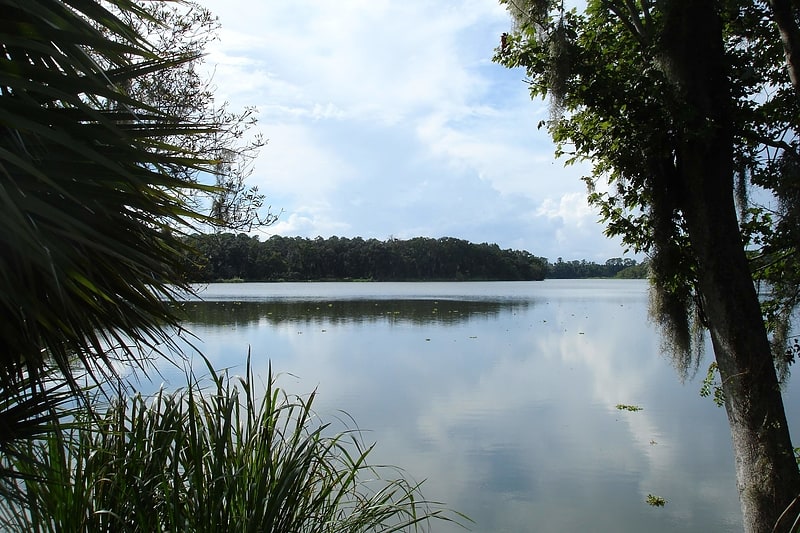
Lake in Florida. Bivens Arm is a body of water in Gainesville, Florida. Located west of U.S. Route 441 and south of Archer Road, it is a part of Paynes Prairie. Bivens Arm is a small shallow lake covering approximately 189 acres in southwest Gainesville. Bivens Arm is a unique environment, which supports a wide diversity of plant and animal life in an urban setting. Tumblin Creek, which is fed by small springs and seeps, drains into Bivens Arm and is the primary source of drainage into the lake. Bivens Arm overflows onto Paynes Prairie and eventually discharges to the aquifer via Alachua Sink.[20]
Constans Theatre
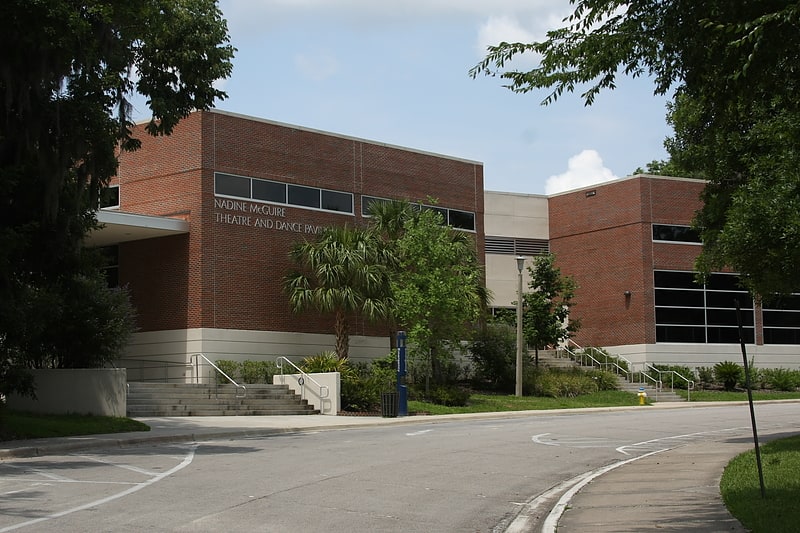
Theatre in Gainesville, Florida. The Constans Theatre is a performing arts venue located on the University of Florida campus in Gainesville, Florida.[21]
Tigert Hall
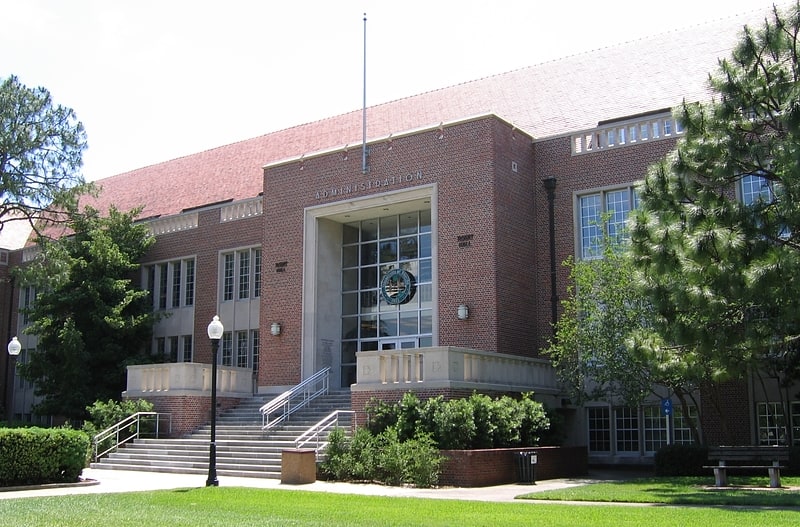
University in Gainesville, Florida. Tigert Hall, built in the late 1940s and early 1950s, is a historic administrative building located on the eastern edge of the University of Florida campus in Gainesville, Florida. It was designed by architect Jefferson Hamilton in a modified Collegiate Gothic style to function as the university's main administration building. In 1960, it was renamed for John J. Tigert, the university's third president, who served from 1928 to 1947. Tigert Hall faces S.W. Thirteenth Street, one of the major public roads adjoining the university's campus.
Tigert Hall became a contributing property in the University of Florida Campus Historic District in 2008; the historic district had been previously added to the National Register of Historic Places on April 20, 1989.[22]
Boulware Springs Water Works
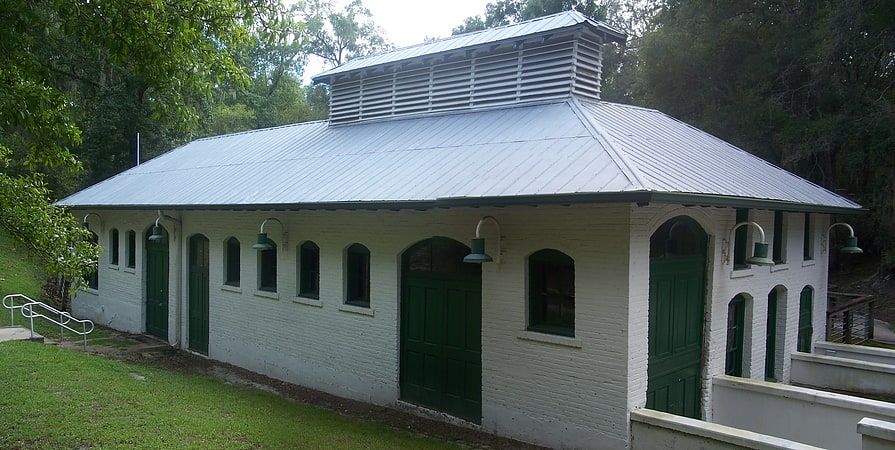
Historical place in Gainesville, Florida. The Boulware Springs Water Works is a historic site in Gainesville, Florida, United States. It is located at 3400 Southeast 15th Street. On June 20, 1985, it was added to the U.S. National Register of Historic Places. It is also the western terminus of the Gainesville-Hawthorne State Trail.
The spring was the site of an 1854 meeting where area citizens voted to create a new town (Gainesville) to replace Newnansville as the Alachua County seat. The spring was the source of city water until 1913 and was important in the city's growth. The University of Florida moved from Lake City to Gainesville in 1901 because the city promised the university free water for life, from the Boulware Springs. The University of Florida still does not pay for water, even though the springs are no longer used in Gainesville's water system.[23]
Century Tower
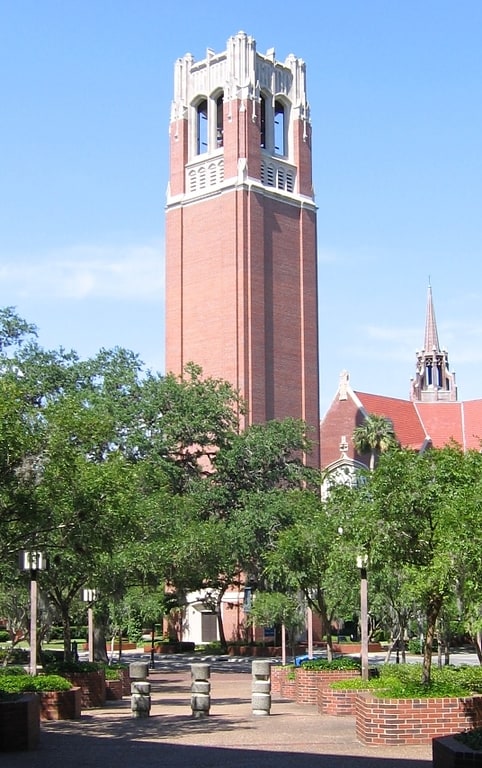
Tower in Gainesville, Florida. The Century Tower is a 157-foot-tall carillon tower in the center of the University of Florida campus in Gainesville, Florida, United States.[24]
Address: MUB 326 University of Florida P.O. Box 117900 Gainesville, FL 32611-7900, Gainesville
Carleton Auditorium
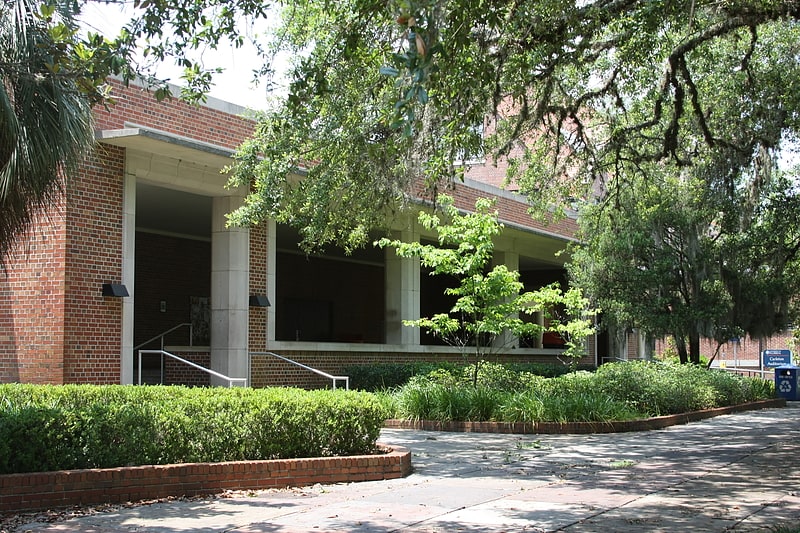
Auditorium in Gainesville, Florida. The William G. Carleton Auditorium, built in 1954, is a historic building on the campus of the University of Florida in Gainesville, Florida, in the United States. Like several other buildings on campus, it was designed by architect Guy Fulton in an early campus Brutalist style, and it is joined to Walker Hall by a breezeway. It seats 680 and was used as a lecture hall for the University College. In 1970, it was renamed for William G. Carleton, longtime professor of history and social sciences known for the colorful presentation of his freshman "American Institutions" lectures.
In 2008 Carleton Auditorium became a contributing property in the University of Florida Campus Historic District which was added to the National Register of Historic Places on April 20, 1989.[25]
Plaza of the Americas

The Plaza of the Americas is a major center of student activity on the campus of the University of Florida in Gainesville, Florida. It is located in the quad between Library West, Peabody Hall, the University Auditorium, and the Chemistry Building.
In 2008 the Plaza of the Americas became a contributing property in the University of Florida Campus Historic District which was added to the National Register of Historic Places on April 20, 1989.[26]
Glen Springs
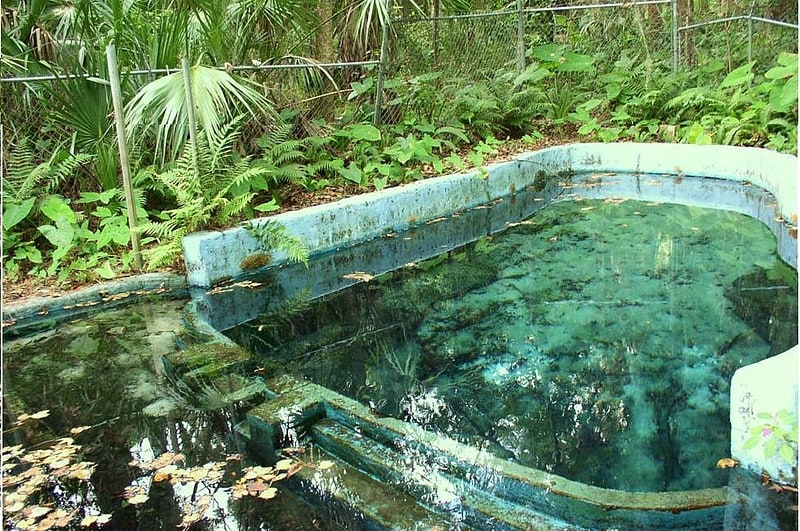
Glen Springs is a 5th magnitude hydrological spring in Gainesville, Florida, United States, located at 2424 NW 23rd Boulevard. Formerly a popular swimming and recreation area, the property closed to the public in 1970 and is no longer maintained for swimming.[27]
Baughman Center
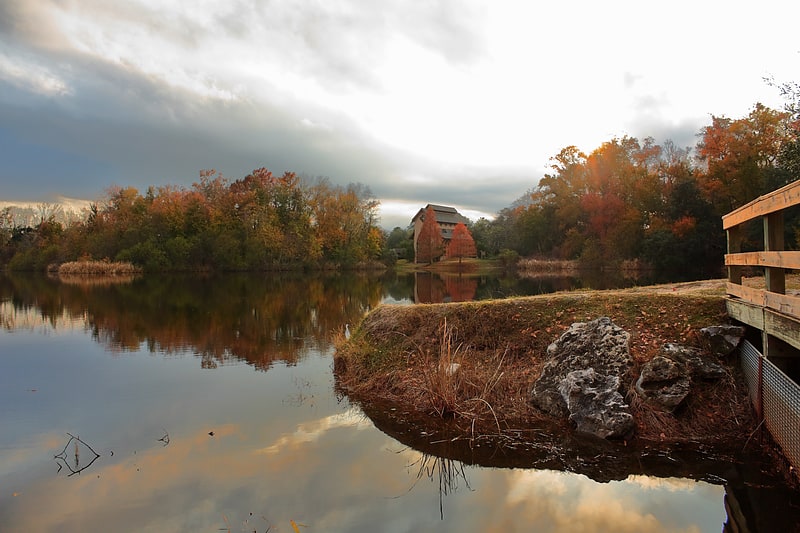
Building complex. The Baughman Center consists of two buildings located along Lake Alice on the University of Florida campus. The main building is a 1,500-square-foot nondenominational chapel or pavilion, while the other one is an 1,000-square-foot administrative building. The chapel has seating for 96 people and is used for silent meditation, private contemplation, weddings, funerals and memorial services as well as a venue for small musical or performing arts events. The center, named after Dr. George F. Baughman and his wife, Hazel Baughman, the benefactors of the project and is considered an oasis of calm and beauty on the bustling campus. On April 18, 2012, the American Institute of Architects's Florida Chapter ranked the Baughman Center third on its list of Florida Architecture: 100 Years. 100 Places.[28]
Seagle Building
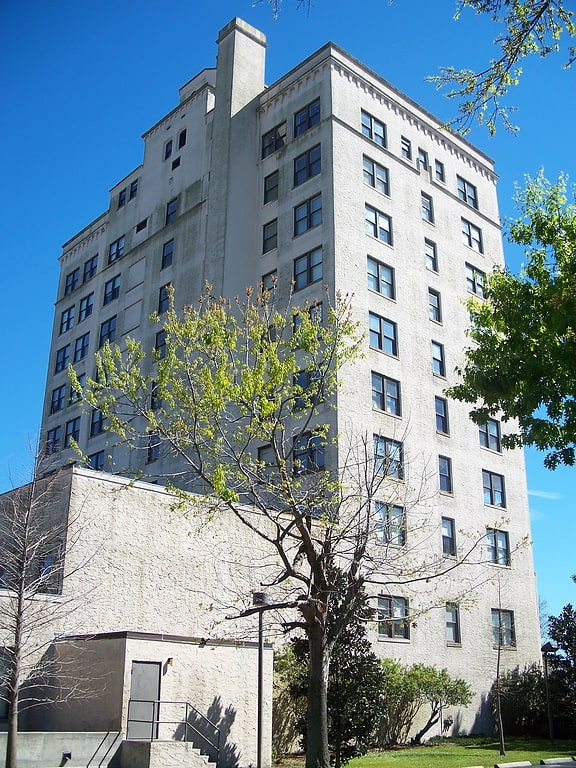
Building in Gainesville, Florida. The John F. Seagle Building is a historic building located at 408 West University Avenue in Gainesville, Florida, in the United States. Built in 1926, it was designed by noted University of Florida architect and professor Rudolph Weaver and built by G. Lloyd Preacher & Company.
On August 16, 1982, it was added to the National Register of Historic Places as the Dixie Hotel, Hotel Kelley.[29]
Address: 408 W University Ave, Gainesville
Newnans Lake

Lake in Florida. Newnans Lake is a lake located off State Road 20, east of Gainesville, Florida. Approximately 1.12 miles wide, Newnans Lake is home to many forms of wildlife, and had been designated as a protected site by Alachua County.
The lake was originally known as Lake Pithlachocco. It was renamed after Daniel Newnan, who led a detachment of Georgia militia that fought an inconclusive battle with Seminoles near the lake in 1812.
Newnans Lake is located 8 kilometres (5.0 mi) east of Gainesville. It averages 1.5 metres (4.9 ft) deep, and has a maximum depth of 3.6 metres (12 ft). It has an area of approximately 3,000 hectares (7,400 acres). Surface flow into the lake is primarily from the north, via Hatchett Creek, Little Hatchett Creek, and other streams. The lake's drainage basin has an area of 308 square kilometres (119 sq mi). The primary outlet is Prairie Creek on the south side of the lake. A spillway as installed in 1967 to control the water level of the lake. It is classified as eutrophic. Before the spillway was installed, the water level of the lake fluctuated seasonally. The margins of the lake are dominated by Cypress swamp forests. Forty-four archaeological sites have been identified on the shores of the lake, or at nearby ponds and marshes. The lake has been designated a Fish Management Area by the Florida Fish and Wildlife Conservation Commission and the Alachua County Board of County Commissioners.
Prairie Creek, the principal outlet of Newnans Lake, originally drained into Paynes Prairie. The Camp family, which owned Paynes Prairie and operated a cattle ranch on it, wanted to drain the prairie to improve it as pasture. After very heavy rain flooded the Prairie in 1927, the Camps commenced projects to lower the water table on the Prairie that included diverting Prairie Creek to the River Styx, which flows into Orange Lake.
In the Spring and Summer of 2000, a drought revealed canoe remnants. Fifty-five of the canoes were analyzed through radiocarbon assays, which showed 41 of them to date to between 2300 and 5000 B.C. The wood choice and manufacturing techniques were comparable to other Archaic Period canoes. The discovery led to the site's addition to the National Register of Historic Places in March 2001.
The 1,005-acre (407 ha) Newnans Lake State Forest is located to the west of the lake. The Newnans Lake Conservation Area owned by the St. Johns River Water Management District is primarily along the north end of the lake.[30]
Dove World Outreach Center
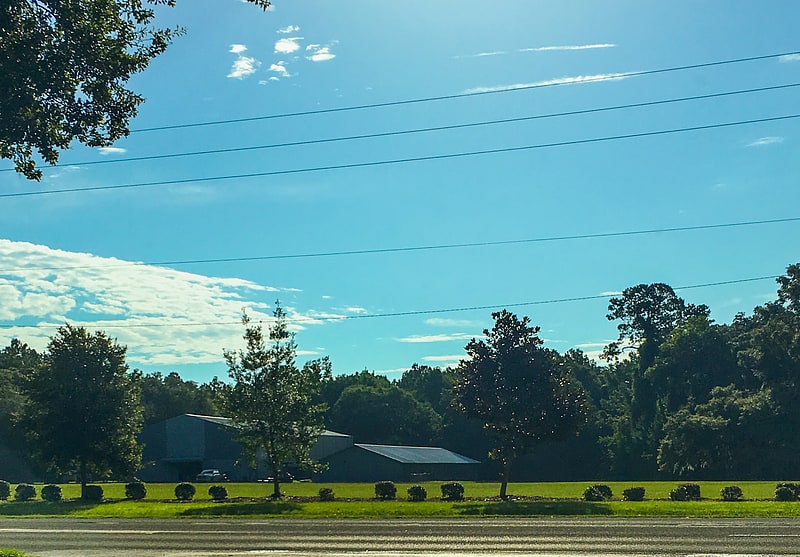
Christian church in Gainesville, Florida. Dove World Outreach Center is a 50-member non-denominational charismatic Christian church led by pastor Terry Jones and his wife, Sylvia. After spending more than 25 years in Gainesville, Florida, the church sold its 20 acres of property in July 2013 and plans to relocate to Tampa. The church first gained notice during the late 2000s for its public displays and criticism of Islam and gay people, and was designated as a hate group by the Southern Poverty Law Center. It became widely known for its pastor's controversial plan to burn Qur'ans on the ninth anniversary of the September 11 attacks.
On September 11, 2010, Jones announced his church would never be burning Qur'ans and that he had reached his goal of exposing elements of Islam as dangerous and radical. On March 20, 2011, however, Jones carried through on his threat, and burned a Qur'an. On April 1, 2011, protesters in the northern Afghanistan city of Mazar-i-Sharif, protesting at this burning, attacked a United Nations Assistance Mission, killing at least 12 people, including at least 7 U.N. workers. Jones described Islam as a false religion that will lead people to hell, and urged to Muslims that the Bible is the only way to God. The congregation held rallies against Gainesville mayor Craig Lowe for being openly gay, and his staff for their purported liberal policies.
A Dove World congregation also held a protest against the building of Park51. After Obama's endorsement of gay marriage, the church hanged an Obama effigy with a rainbow flag on its lawn.[31]
Northeast Gainesville Residential District

The Northeast Gainesville Residential District, also known locally as the Duck Pond is a U.S. historic district located in Gainesville, Florida. It encompasses approximately 1,660 acres, bounded by 1st, and 9th Streets, 10th and East University Avenues. It contains 229 historic buildings.[32]
University of Florida

Land-grant university in Gainesville, Florida. The University of Florida is a public land-grant research university in Gainesville, Florida. It is a senior member of the State University System of Florida, traces its origins to 1853, and has operated continuously on its Gainesville campus since September 1906.
After the Florida state legislature's creation of performance standards in 2013, the Florida Board of Governors designated the University of Florida as one of the three "preeminent universities" among the twelve universities of the State University System of Florida. For 2022, U.S. News & World Report ranked Florida as the 5th (tied) best public university and 28th (tied) best university in the United States. The University of Florida is the only member of the Association of American Universities in Florida and is classified among "R1: Doctoral Universities – Very high research activity".
The university is accredited by the Southern Association of Colleges and Schools (SACS). It is the third largest Florida university by student population, and is the fifth largest single-campus university in the United States with 57,841 students enrolled for during the 2020–21 school year. The University of Florida is home to 16 academic colleges and more than 150 research centers and institutes. It offers multiple graduate professional programs—including business administration, engineering, law, dentistry, medicine, pharmacy and veterinary medicine—on one contiguous campus, and administers 123 master's degree programs and 76 doctoral degree programs in eighty-seven schools and departments. The university's seal is also the seal of the state of Florida, which is on the state flag, though in blue rather than multiple colors.
The University of Florida's intercollegiate sports teams, commonly known as the "Florida Gators", compete in National Collegiate Athletic Association (NCAA) Division I and the Southeastern Conference (SEC). In their 111-year history, the university's varsity sports teams have won 42 national team championships, 37 of which are NCAA titles, and Florida athletes have won 275 individual national championships. In addition, as of 2021, University of Florida students and alumni have won 143 Olympic medals, including 69 gold medals.[33]
Matherly Hall
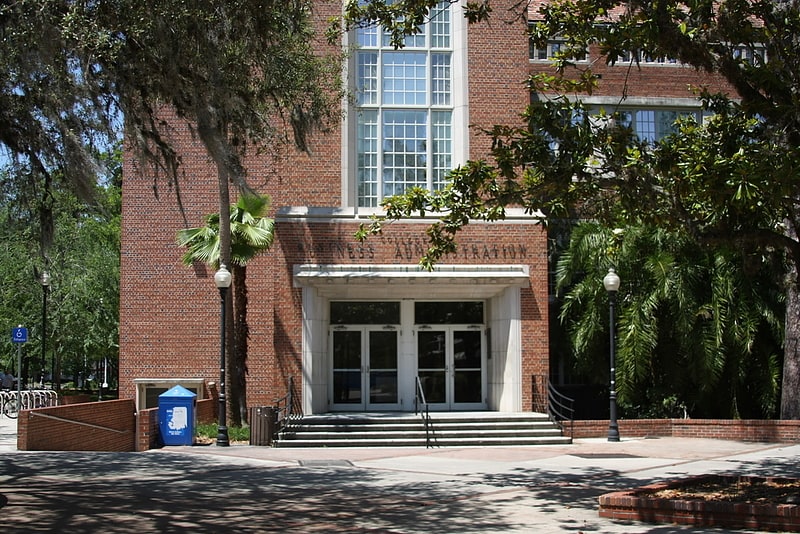
University department in Gainesville, Florida. Matherly Hall built in the early 1950s is an historic classroom and faculty office building on the campus of the University of Florida in Gainesville, Florida, in the United States. It was designed by Guy Fulton in a modified Collegiate Gothic style to house the College of Business Administration. It is named for Walter Jeffries Matherly, dean of the business college from 1926 to 1954.
In 2008 Matherly Hall became a contributing property in the University of Florida Campus Historic District which was added to the National Register of Historic Places on April 20, 1989.[34]
Address: 1405 W University Ave, Gainesville
34th Street Wall
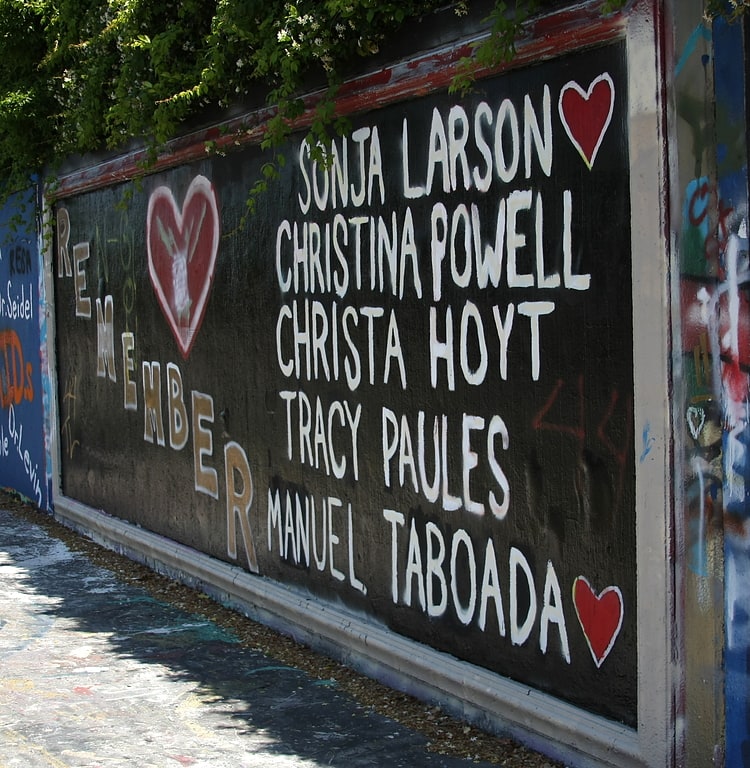
Historical landmark in Gainesville, Florida. The 34th Street Wall is a 1,120-foot-long retaining wall along SW 34th Street in Gainesville, Florida. It was constructed in 1979 by the Florida Department of Transportation to prevent erosion on the adjoining University of Florida golf course when the road was widened from two to four lanes, necessitating cutting through a small hill.
The otherwise nondescript poured concrete wall is notable for being almost entirely covered by graffiti, and it has served as an sort of ever-changing bulletin board for the Gainesville community since the 1980s. Items painted on the wall have included marriage proposals, birthday wishes, graduation announcements, celebration of athletic victories, activist and public awareness statements, tributes, promotions, and memorials, including two permanent memorial panels for victims of the Danny Rolling murders and Gainesville native Tom Petty. Although most of the graffiti is painted by university students and other members of the community, there is occasional tagging and professional art. After decades of use, it is estimated that paint on the center of the wall is about 250 layers thick.[35]
Address: 34th St, Gainesville